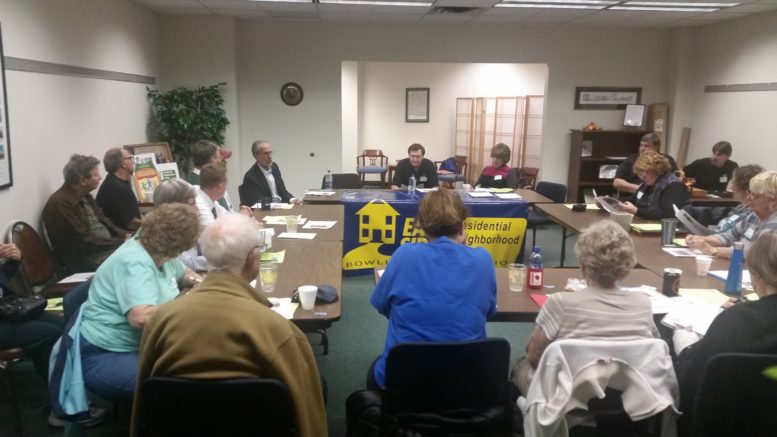By JAN LARSON McLAUGHLIN
BG Independent News
East Side residents met this week with their neighbor that brings the best perks and biggest problems for them – Bowling Green State University.
The neighborhood association heard from Steve Krakoff, vice president of capital planning, and Bob Waddle, assistant vice president of capital planning for the university. The two explained the big push on campus to renovate solid structures, tear down obsolete buildings, and build new ones.
For East Side residents, that means almost constant construction at their neighbor’s.
But Rose Hess said the neighbors are willing to tolerate that disturbance. “Nobody has even complained of a caterpillar turning into a butterfly,” she said.
Meanwhile, the dividing line between campus and the East Side neighborhood – East Wooster Street – is also a focus for the city and the university. The East Wooster corridor is divided into three sections – Main to Thurstin and Manville streets, the section in front of the university, and Mercer to Dunbridge roads.
“This is where the city and the university come together to improve our future,” Krakoff said. “Our futures are very much tied together.”
The university recently purchased two more properties on East Wooster Street, just east of South College Street. BGSU officials have no specific plans yet for those properties, Waddle said.
“It was an opportunity to get those houses,” he said to East Side neighbors. “Hopefully in a lot of ways it will be an improvement.”
“We will continue to buy properties along Wooster Street where we think it makes sense,” Krakoff said.
East Siders have already seen improvements with the new Greek housing and the new Kuhlin Center which resulted in a major facelift for South Hall, all along East Wooster Street.
Krakoff cautioned that the construction will be ongoing as BGSU tries to stop campus sprawl and focus on the center of the campus.
“The campus needs to get smaller, it just does,” he said.
Harshman residence hall, along East Wooster Street, will be coming down before long, Krakoff said. Not only is that building unattractive and old, but less on-campus housing is needed with the decline in traditional students coming to college straight from high school.
“In most places in the country, that key demographic is getting smaller,” he said.
In 10 years or so, Kreischer Hall will be next to go, Krakoff said. Some older classroom buildings will also be torn down, including West Hall and the Family & Consumer Science building.
Meanwhile, BGSU is focusing on modernizing other classroom buildings, such as Moseley, University and Hanna halls. “We want to start pumping some money into those remaining,” he said.
A push is also on to make the campus more attractive – more of a memorable “collegiate environment,” Krakoff said.
While residential housing on campus will be shrinking, the university will be looking at more use of off-campus apartments for students. BGSU previously purchased the apartment buildings by the Stroh Center, and have found them to be popular with students.
So the university is considering building or renovating apartments “around the edges” of campus, Krakoff said. That may include townhouse like buildings on the south side of Wooster Street, “that backs up to your neighborhoods.”
Mixed used structures, with retail on the first floor and apartments above are being considered as possibilities in the area of Wooster/Manville/Thurstin streets, he added.
Waddle also talked about the two houses purchased by BGSU at 141 and 145 Troup Street, in between two houses already owned by the university. The newly purchased homes will be used as forensic crime scene training sites for the BCII program on campus.
“We want to create very, very real crime scenes,” Waddle said.
Both Krakoff and Waddle said they will return to the East Side Neighborhood Association to present updates in the future.

